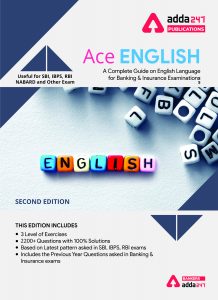Directions (1-10): Read the following passage carefully and answer the questions given below it. Certain words have been printed in bold to help you to locate them while answering some of the questions.
Hard cases, it is said, make bad law. The adage is widely considered true for the Supreme Court of India which held in the height of the Emergency, in ADM Jabalpur v. Shivkant Shukla that detenus under the Maintenance of Internal Security Act (MISA) could not approach the judiciary if their fundamental rights were violated. Not only was the law laid down unconscionable, but it also smacked of a Court more “executive-minded than the executive”, complicit in its own independence being shattered by an all-powerful government. So deep has been the impact of this judgment that the Supreme Court’s current activist avatar is widely viewed as having its genesis in a continuing need to atone.
Expressions of such atonement have created another Court made to measure — this time not to the measure of the government but rather the aggrandised self-image of some of its judges.
Let us look back to the ADM Jabalpur case. As a court of law, the Supreme Court was called upon in the case to balance the interest of public order in an Emergency with the right to life and personal liberty guaranteed to every person. Nine High Courts called upon to perform the same function had found a nuanced answer by which they had held that the right to life cannot be absolutely subservient to public order merely because the government declared so — the legality of detentions could be judicially reviewed, though the intention of the government would not be second-guessed by the Court. This was a delicate balance. The Supreme Court however reversed this view and made the right to life and personal liberty literally a bounty of the government. Given that the consequences of their error were entirely to the government’s advantage, it was widely viewed as the death of an independent judiciary. The excessively deferential, almost apologetic language used by the judges confirmed this impression.
Today, however, while public interest litigation has restored the independent image of the Supreme Court, it has achieved this at the cost of quality, discipline and the constitutional role judges are expected to perform. The Court monitors criminal trials, protects the environment, regulates political advertising, lays down norms for sexual harassment in the workplace, sets guidelines for adoption, supervises police reform among a range of other tasks of government. That all these tasks are crucial but tardily undertaken by government can scarcely be questioned. But for an unelected and largely unaccountable institution such as the Supreme Court to be at the forefront of matters relating to governance is equally dangerous — the choice of issues it takes up is arbitrary, their remit is not legal, their results often counterproductive, requiring a degree of technical competence and institutional capacity in ensuring compliance that the Court simply does not possess. This sets an unhealthy precedent for other courts and tribunals in the country, particularly the latter whose chairpersons are usually retired Supreme Court Justices. To take a particularly egregious example, the National Green Tribunal has banned diesel vehicles more than 10 years old in Delhi and if reports are to be believed, is considering imposing a congestion charge for cars as well. That neither of these are judicial functions and are being unjustly being usurped by a tribunal that has far exceeded its mandate, is evidence of the chain reaction that the Supreme Court’s activist avatar has set off across the judicial spectrum.
Finally, the Court’s activism adds to a massive backlog of regular cases that makes the Indian justice delivery mechanism, slow, unreliable and inefficient for the ordinary litigant. As on March 1, 2015, there were over 61,000 cases pending in the Supreme Court alone. It might be worthwhile for the Court to set its own house in order, concomitantly with telling other wings of government how to do so.
As we mark 40 years of the Emergency and the darkest period in the Supreme Court’s history, it might be time to not single-mindedly harp on the significance of an independent judiciary. Judicial independence, is and must remain a cherished virtue. However, it would be blinkered to not confront newer challenges that damage the credibility of our independent judiciary today — unpardonable delays and overweening judges taking on the mantle of national government by proxy. The Supreme Court 40 years on is a different institution — it must be cognizant of its history but not at the cost of being blind to its present.
Q1. Which of the following is a suitable title for the passage?
(a) An Atonement Gone Too Far
(b) Sanctimony from a Ruined Pedestal
(c) The ADM Jabalpur’s Case: The Supreme Court’s Darkest Hour
(d) Overcompensating for Past Mistakes
(e) Litigating public’s interest.
Q2. The author says that the Supreme Court was “more executive-minded than the executive” during the Emergency. Which of the following options captures the essence of what the writer means by the phrase: ‘more “executive-minded than the executive”’?
(a) The Supreme Court abdicated its independence to an authoritarian government by embracing its perspective.
(b) The Supreme Court was more emphatic than the Government about exercising executive power under the MISA.
(c) The Supreme Court reflected the unconscionable actions taken by the government by upholding its laws.
(d) The Supreme Court wanted to curry favor with the government through its deferential decisions during Emergency.
(e) None of these.
Q3. Which of the following cannot be reasonably inferred from the passage?
(a) The Supreme Court was complicit in curbing judicial independence during the Emergency.
(b) Public interest litigations have, post-Emergency, led to the judiciary overreaching into the realm of legislature.
(c) The Indian Judiciary ought not indulge in general supervisory jurisdiction to correct actions and policies of government.
(d) The Indian judiciary must be equipped with technical competence and institutional capacity to ensure compliance to orders passed in relation to public interest litigations.
(e) None of these.
Q4. The word “egregious” in the passage is farthest in meaning to:
(a) outrageous
(b) flagitious
(c) distinguished
(d) arrant
(e) affliction
Q5. Which of the following is the author least likely to agree with?
(a) The rise in judicial activism is in danger making the Supreme Court diffuse and ineffective, encroaching into the functions of government.
(b) Where the Supreme Court is only moved for better governance and administration, which does not involve the exercise of any proper judicial function, it should refrain from acting.
(c) Adoption, police reform and environment issues are the remit of the judiciary.
(d) The Indian judicial system needs to focus on clearing the massive backlog of cases to re-establish its credibility.
(e) None of these.
Q6. What is the most widely viewed reason for the Supreme Court’s current avatar?
(a) To represent the aggrandized self-image of some of its judges.
(b) As the Supreme Court wants to achieve public litigation at the cost of quality, discipline and the constitutional role judges are expected to perform.
(c) Reparation for its genuflection before the government.
(d) They are doing it as atonement for not complying with the government in the hour of the greatest need.
(e) None of these.
Directions (7-7): Choose the word/group of words which is MOST SIMILAR in meaning to the word/ group of words printed in bold as used in the passage.
Q7. Litigant
(a)plaintiff
(b)garrison
(c)squadron
(d)fortify
(e)militia
Directions (8-10): Choose the word/group of words which is MOST OPPOSITE in meaning to the word/ group of words printed in bold as used in the passage.
Q8. Complicit
(a)connivance
(b)abetment
(c)complot
(d)manipulation
(e)non involvement
Q9. Atonement
(a) Reparation
(b) Restitution
(c) Defiance
(d) Expiation
(e) indemnity
Q10. Nuanced
(a) Shade
(b) Accord
(c) Gradation
(d) Variation
(e) Subtlety
Directions (11-15): Rearrange the following seven sentences (A), (B), (C), (D), (E), (F) and (G) in the proper sequence to
form a meaningful paragraph; then answer the question given below them.
A. They have to, therefore, necessarily devise strategies for product differentiation and pricing, market segmentation and efficient portfolio management.
B. There is a great need for the banks to fully exploit these sectors to achieve a win-win situation for both—the farm and non-farm sector units and the banks.
C. The time has now come to consolidate on the gains of the past decades of nationalised banking.
D. This means banks will no longer be operating in a “seller’s market”.
E. Undoubtedly, an untapped and vibrant market for commercial banking exists in the farm and non-farm sectors of rural economy.
F. Then, and only then, could it be claimed that the nationalisation has, at least to some extent, achieved the purpose of nationalisation.
G. The present era of financial liberalisation and globalised banking would entail that banks equip themselves to face the rigours of a highly competitive financial market.
Q11. Which of the following should be the SECOND sentence after rearrangement?
(a) G (b) F (c) E
(d) D (e) C
Q12. Which of the following should be the THIRD sentence after rearrangement?
(a) G (b) F (c) A
(d) D (e) B
Q13. Which of the following should be the FIFTH sentence after rearrangement?
(a) G (b) F (c) E
(d) B (e) D
Q14. Which of the following should be the FIRST sentence after rearrangement?
(a) G (b) F (c) E
(d) D (e) C
Q15. Which of the following should be the SEVENTH sentence after rearrangement?
(a) G (b) F (c) E
(d) C (e) D
Solutions
S1. Ans. (a)
Sol. This title summarizes the main idea of the passage very well. The passage talks of the Supreme Court’s unconscionable stance during the Emergency and its subsequent “activist avatar” to atone.
S2. Ans. (b)
Sol. This option is right on target in explaining why, according to the author, the Supreme Court was “more” executive-minded (unyielding) than the executive (the government) in enforcing the MISA and curbing fundamental rights.
S3. Ans. (d)
Sol. This is false. The author believes that the Supreme Court should focus on only judicial functions and not act in matters relating to governance where it does not have the competence or capacity to ensure compliance.
S4. Ans. (c)
Sol. The word “distinguished”, which means extraordinary in a good way, is the word farthest in meaning to egregious.
S5. Ans. (c)
Sol. Adoption, police reform and environment issues are some topics the passage mentions are “crucial tasks” that are “tardily” dealt with by the government, but outside the remit of the Supreme Court. The author is unlikely to agree with statement c.
S6. Ans. (c)
Sol. The whole passage is dedicated towards this issue is how supreme court is still atoning for bowing down to government.
S7. Ans. (a)
Sol. Litigant means a person involved in a lawsuit hence plaintiff is the word most similar in meaning.
S8. Ans. (e)
Sol. Complicit means involved with others in an activity that is unlawful or morally wrong hence non-involvement is the word most opposite in meaning.
S9. Ans. (c)
Sol. Atonement means the action of making amends for a wrong or injury hence defiance is the word most opposite in meaning.
S10. Ans. (b)
Sol. Nuanced means a subtle difference in or shade of meaning, expression, or sound hence accord is the word most opposite in meaning.
S11. Ans. (a)
Sol. The correct sequence is CGDEBAF.
S12. Ans. (d)
Sol. The correct sequence is CGDEBAF.
S13. Ans. (d)
Sol. The correct sequence is CGDEBAF.
S14. Ans. (e)
Sol. The correct sequence is CGDEBAF.
S15. Ans. (b)
Sol. The correct sequence is CGDEBAF.





 English Language Quiz For Bank Foundatio...
English Language Quiz For Bank Foundatio...
 English Language Quiz For Bank Mains Exa...
English Language Quiz For Bank Mains Exa...


